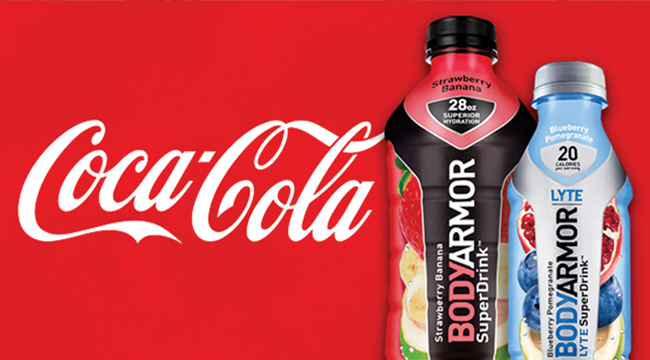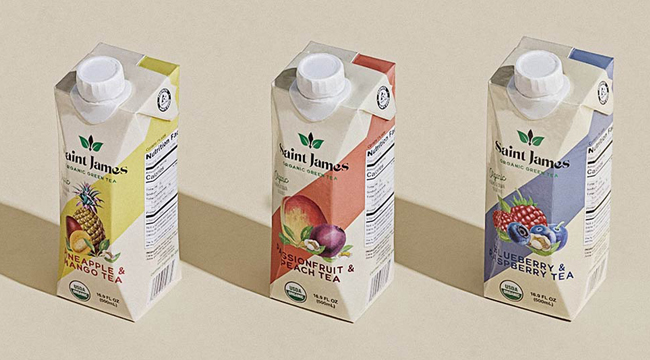Bevscape: The Latest Beverage Brand News
Coke Acquires BodyArmor for $5.6 Billion
control of sports drink maker BodyArmor for $5.6 billion, its largest acquisition to date.
The beverage giant exercised its option to purchase BodyArmor in full at a pre-existing discount, as included in a 2018 deal that gave Coke U.S. distribution rights to BodyArmor and a 15% stake in the brand.
According to a press release, New York-based BodyArmor will be managed as a separate business within Coke’s North America operating unit and its current executive leadership team, including co-founder and chairman Mike Repole and president Brent Hastie, will remain with the brand through at least 2022 and will work “on vision and strategy for 2023 and beyond.”
“BODYARMOR has been a great addition to the system lineup over the last three years, and the company has driven continuous innovation in hydration and health-and-wellness products,” said Alfredo Rivera, president of the North America operating unit of Coke, in a press release. “We’re excited to bring BODYARMOR into The Coca-Cola Company and work with Mike Repole and his leadership team on the next stage of growth.”
In the past year BodyArmor has emerged as the number two brand in the sports drink category, overtaking Coke’s own Powerade. According to NielsenIQ, BodyArmor has a 16.5% dollar share of the category, while Coke has an existing share of 13.8% for the 52-week period ending October 9. Meanwhile, Gatorade owner PepsiCo controls 66.3% of the space.
In the same period, dollar sales of BodyArmor have increased 46.9% to about $1.3 billion, while Coke’s portfolio was up just 2.4% to $1.1 billion and PepsiCo rose 12.1% to $5.5 billion.
BodyArmor was co-founded in 2011 by Repole and serial entrepreneur Lance Collins and Repole, who had previously co-founded Glaceau, the maker of Vitaminwater and Smartwater, which sold to Coke in 2007 for $4.1 billion. In 2013, NBA All-Star Kobe Bryant joined BodyArmor as a director and the company’s third largest shareholder, as well as a prominent face of the brand.
“Ten years ago, we set out with a vision to create a better-for-you sports drink with a goal of becoming the #1 global sports drink,” Repole said in the release. “Our talented leadership team under Brent Hastie, our 400 dedicated employees and incredible Coca-Cola bottling partners have helped us build this remarkable brand. If it wasn’t for Kobe Bryant’s vision and belief, BODYARMOR would not have been able to achieve the success we had. I couldn’t be more excited to become part of the Coca-Cola family and set our sights on the future.”
The announcement was released at exactly 8:24 a.m. EST on a Monday morning to pay tribute to Bryant, who died last year, with the time representing the two different jersey numbers he wore during his tenure with the Los Angeles Lakers. Bryant’s estate is expected to receive about $400 million for his stake in the brand.
As well, Coke is buying out Keurig Dr Pepper’s (KDP) 12.5% stake in the company. According to Goldman Sachs Equity Research, KDP’s stake is valued at $825 million. A report in Seeking Alpha added that KDP had purchased the stake for $25 million.
But it’s not just KDP and Bryant’s family who have seen their investment in BodyArmor pay off. According to Nick Giannuzzi and Ryan Lewendon, partners of law firm Giannuzzi Lewendon which represented BodyArmor in negotiations, roughly 50% of the brand’s 400 employees are set to receive over $1 million in the transaction, ranging from executives to lower level staff.
Lewendon noted that outside of some family offices the cap table had almost no private equity or funds involved and most of the company’s investments came from individuals.
“It was unbelievable to see how something like this could change so many lives and almost everyone it helped was someone who helped build the brand,” Giannuzzi told BevNET. “Mike brings everybody in, everybody’s a partner.”
The deal has been in the works since at least February, when Coke notified U.S. antitrust regulators that it was seeking to acquire a controlling stake in BodyArmor. Goldman Sachs estimated the final valuation at around $6.6 billion or a higher-than-average 6.7x sales multiple.
At $5.6 billion, the BodyArmor acquisition passed Coke’s $5.1 billion purchase of Costa Coffee in 2018 as the largest in company history. The deal also comes at a time where Coke has aimed to double down on its larger brand acquisitions, notably Costa and Topo Chico, and has divested under-performing brands like Zico and Odwalla. In recent years, Coke has also passed on several acquisition opportunities, including Health-Ade and Suja, after making initial investments in those companies.
As part of the agreement, Repole will work on developing new marketing, packaging and innovation strategies across Coke’s still beverages portfolio, the release stated.
Analysts responded favorably to the announcement, stating that the “long anticipated” deal provides BodyArmor with a global expansion opportunity while Coke is now positioned to tackle Gatorade head-on with an innovation-driven brand.
Howard Telford, senior head of soft drinks at Euromonitor International, said in a statement that the acquisition exemplifies Coke’s interest in expanding its functional beverage offerings, noting that BodyArmor has benefited from better-for-you positioning with low calorie and no added sugar products.
Ahead of the acquisition, Credit Suisse announced it was positive on the prospective deal, stating that “Over time, we expect Coke will roll out BodyArmor globally, replicating the ‘Monster-model.’” The report noted that Monster has quadrupled its international business in the last eight years from $500 million to $2 billion. As well, BodyArmor has significant room to grow, the report suggested, as rolling six month velocities of $95,000 currently trail behind Gatorade ($150,000). However, the brand has a strong ACV of about 90%.
Goldman Sachs Equity Research said Coke “is acquiring a highly attractive beverage asset” with significant momentum and strong category fundamentals. With Powerade also in its portfolio, Coke still controls less than half of the market share for sports drinks. However, the report suggested that as the category is expected to reach $15 billion by 2030 (up from $7.5 billion in 2021), Coke appears likely to continue positioning BodyArmor as a premium brand while Powerade will serve as a value product.
Lewendon said Coke primarily sees Powerade and BodyArmor as servicing two different consumer bases, with BodyArmor acting as “much more of a lifestyle brand than a sports drink.”
Looking ahead, Giannuzzi and Lewendon said the deal also reflects the expanded opportunity for disruption within the food and beverage industry. While strategics may now have higher standards for acquisitions, choosing to purchase high performing brands that are “winning their category,” the chance to create those brands has also risen. Lewendon noted that when BodyArmor launched, trying to compete in the sports drink category was “sacrosanct,” but the better-for-you trend has changed the game and BodyArmor’s record high price is the proof.
“There’s an opportunity to rethink everything that’s out there,” Lewendon said. “Nothing is sacrosanct from disruption anymore.”
AriZona Co-Founder John Ferolito Returns To RTD Tea With Saint James
After fighting to exit the RTD tea game, AriZona Iced Tea co-founder John M. Ferolito bought back in.
The beverage entrepreneur announced in September the forthcoming launch of a line of organic green teas called Saint James Tea, available in 16.9 oz. Tetra Paks in four flavors: Original Green Tea, Blueberry & Raspberry Tea, Pineapple & Mango Tea and Passionfruit and Peach Tea. Named in honor of one of Ferolilto’s personal mentors, the drink is meant to “offer a healthy, great-tasting product that is beneficial for people and the planet,” he said in a release.
Saint James marks Ferolito’s return to the RTD tea category, after spending a couple decades building AriZona (alongside fellow co-founder Don Vultaggio) into a powerhouse national brand and the star of parent company Beverage Marketing USA’s portfolio. But his beverage experience extends into alcohol via a track record in beer through Hornell Brewing, and malt liquor with budget brands Crazy Horse and Midnight Dragon. His exit from AriZona and the subsequent battle over the sale of his 50% ownership stake, valued at around $1 billion, went on for years before the two parties reached a settlement.
Ferolito is joined at Saint James by several other notable names, starting with the brand’s new creative director, Jon Buscemi. The acclaimed footwear and luggage designer is involved with multiple CPG ventures, including Wolves Whiskey and truffle-infused hot sauce maker Truff, but Saint James Tea represents the right opportunity to realize a years-long ambition to get involved in RTD beverages, he said. As one of his first moves, Buscemi tapped multidisciplinary creative studio PLAYLAB, INC. to design the look of Saint James Tea, having done similar work for clients like Adidas and Louis Vuitton.
“From a trend standpoint, what Saint James is doing within the health and wellness space is exploding. It’s the perfect time to introduce an innovative brand like this to the market,” said Buscemi in a press release. “As a nation, we love these drinks, but they are always full of sugar. I’m involved because I love the way it tastes without any regrets.”
The company’s other partners bring additional credentials to the table: that includes Brenden Cohen, CEO of Bond Audio and D’Angelico Guitars, and Roy Warren, Jr., son of the late Roy Warren who created and helmed healthy CPG startups like Bravo Brands, Attitude Drinks and Gratitude Health. Sales veteran Andy Stallone, meanwhile, has come onboard to help manage the brand’s rollout in Florida.


Receive your free magazine!
Join thousands of other food and beverage professionals who utilize BevNET Magazine to stay up-to-date on current trends and news within the food and beverage world.
Receive your free copy of the magazine 6x per year in digital or print and utilize insights on consumer behavior, brand growth, category volume, and trend forecasting.
Subscribe
